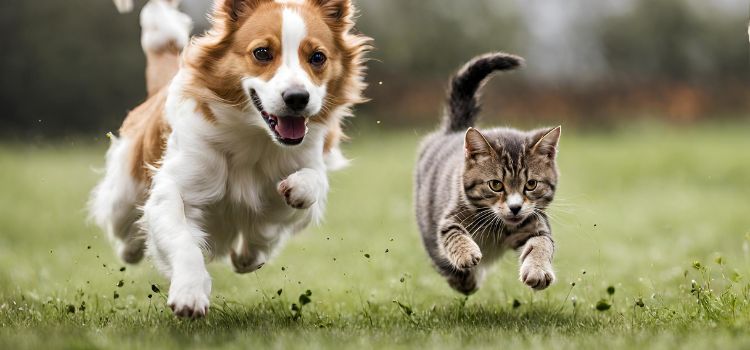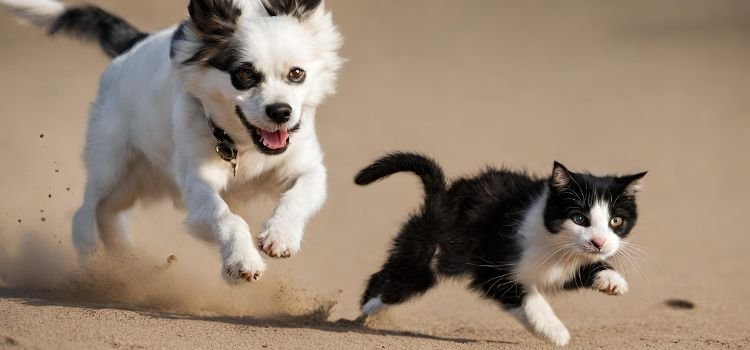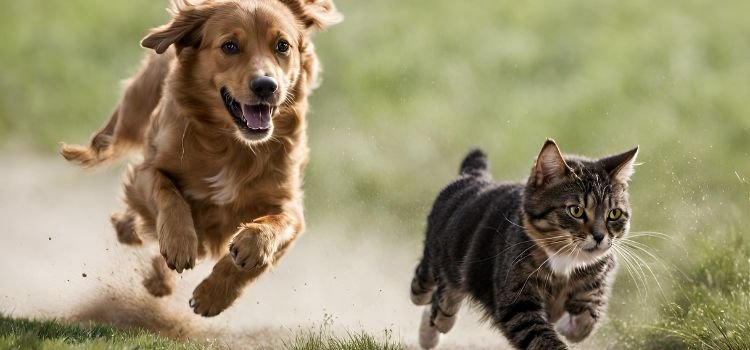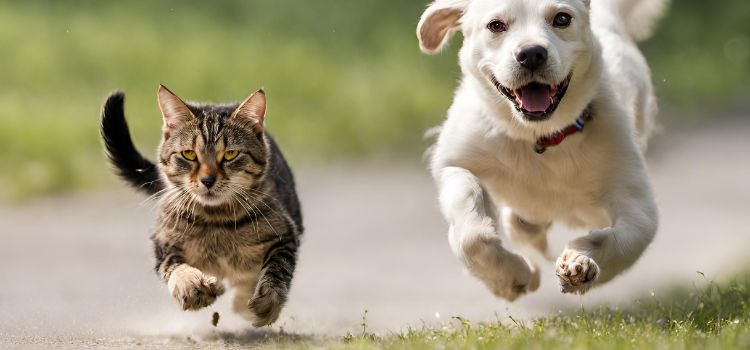As an Amazon Associate committed to the mission of improving the lives of our readers, Live-Clear.com receives a small commission from eligible purchases made through our affiliate links. This revenue enables us to keep producing insightful articles and other material.
To stop dog chasing cat, engage them in positive reinforcement training. First, teach the dog basic commands like sit-stay.
It can be worrisome to watch your dog chasing your cat around the house, or worse, in the backyard. While some dogs simply enjoy the thrill of the chase, it can be dangerous and stressful for your cat. Fortunately, there are ways to curb this behavior and create a peaceful coexistence between your pets.

One of the most effective methods is positive reinforcement training. By teaching your dog basic commands like sit and stay and rewarding good behavior, you can redirect their focus when they begin to chase the cat. Remember, it takes patience and consistency, but with time, your pets can learn to peacefully coexist.
Pre-training Preparation
To stop your dog from chasing your cat, proper pre-training preparation is necessary. This includes teaching your dog basic obedience commands, using positive reinforcement, and gradually introducing them to your cat under controlled situations. With patience and consistency, you can train your dog to coexist peacefully with your feline friends.
Dog And Cat Separation
If you’re having trouble getting your dog to stop chasing your cat, it’s essential to prepare them for training. One of the first steps in pre-training preparation is separating your dog and cat. This means keeping them in separate areas of the house and not allowing them to interact until you’re ready to begin training. Make sure your cat has a designated safe space where your dog can’t access it, such as a high shelf or a separate room with a door that closes securely.
Identifying Triggers
Before starting any training, it’s crucial to identify what triggers your dog’s chase instinct. Common triggers include movement, sound, and scent. Once you know what triggers your dog, you can work on desensitizing them to these stimuli. For example, if your dog is triggered by movement, you can start by having someone move slowly in the same room as your dog, gradually increasing the movement until your dog no longer reacts. Ensure that you don’t overwhelm your dog during the training process. Gradual exposure and desensitization work best.
Training Techniques
After separating your pets and identifying triggers, you can begin the actual training process. Effective training techniques include positive reinforcement and clicker training. Positive reinforcement involves rewarding your dog for good behavior, such as ignoring your cat or responding to a command to “leave it.” Clicker training involves using a clicker to signal to your dog that they have done something correctly, followed by a treat as a reward. This training method can help communicate with your dog more effectively, improving the chances of success.
Pre-training preparation is crucial when it comes to stopping your dog from chasing your cat. Identifying triggers, separating your pets, and using effective training techniques can help you achieve a peaceful home for both your dog and cat.

Training Techniques To Stop Dog Chasing Cat
Teaching your dog not to chase your cat can be a challenging task, but with the right training techniques, it can be accomplished. Consistent positive reinforcement, redirection, and supervision are key to breaking this behavior.
Dogs are natural predators and sometimes when they see a cat, their instincts kick in which makes them want to chase it. If you have a dog that chases your cat, it can be concerning for the safety of your feline friend. However, through the use of different training techniques, you can teach your dog to stop chasing your cat. Here are five proven training techniques that can help you to put an end to this behavior:
Positive Reinforcement Training
Positive reinforcement is a training technique that rewards good behavior. Whenever you notice your dog exhibiting good behavior, give it a treat or a favorite toy. You will reinforce the behavior you want to see and discourage the behavior you want to stop. For instance, when your dog ignores the cat, give it a treat. Keep rewarding your dog as it continues to display the behavior you want to see until it becomes automatic.
Redirecting Techniques
Redirecting your dog’s attention from the cat is another effective technique. You can use a toy or a treat to distract your dog from the cat. Tossing a ball or asking your dog to come when it sees the cat will help to divert your dog from chasing the cat.
No-chase Training
No chase training is all about teaching your dog to recognize and follow commands. It involves teaching commands like “sit” or “stay” that can stop your dog’s chase behavior. When your dog starts chasing your cat, you can command it to “stop” or “sit” or “stay”. Make sure to reward your dog for following the commands that lead to the expected behavior.
Using Deterrents
Deterrents work by helping your dog associate chasing the cat with an unpleasant experience. When your dog starts chasing the cat, you can trigger a negative consequence. One of the most common deterrent methods is a loud noise. You can use an air horn, a whistle or a shaker to make a loud noise when your dog starts to chase the cat. Over time, your dog will associate chasing the cat with a loud noise and stop.
Clicker Training
Clicker training is a form of positive reinforcement that involves using a clicker to signal good behavior and reward your dog. You can train your dog to respond to the sound of the clicker with positive behavior. When your dog starts to chase the cat, the sound of a clicker will distract it from chasing the cat. Over time, your dog will learn to associate the sound of the clicker with good behavior and abandon chasing the cat.
With consistent training, patience and the right techniques, you can teach your dog to stop chasing your cat. Keep in mind that every dog is different and may respond differently to each of these techniques. Be willing to try different techniques and find the one that works best for your dog.

Additional Tips For Success
To successfully stop your dog from chasing your cat, it’s important to consistently train your dog with positive reinforcement and provide them with enough exercise and mental stimulation. It’s also helpful to provide separate areas for your cat and dog to rest, eat, and play.
Consulting with a professional trainer can also provide additional insight and strategies for success.
When it comes to stopping your dog from chasing your cat, patience and perseverance are key. Consistency in your training methods, keeping a cool head, and addressing any underlying behavioral issues are crucial for success. In this section, we’ll dive deeper into these additional tips for successfully stopping the dog from chasing the cat.
Consistency Is Key
Consistency is one of the most important aspects of training your dog not to chase your cat. Establish a set of rules and rewards for your dog and stick to them. For example, if your dog chases the cat, say “No!” in a firm, authoritative voice and give your dog a timeout in a separate room. Be sure to reward positive behavior, such as when your dog stays calm in the presence of your cat.
Keeping Your Cool
It’s important to remain calm when training your dog to stop chasing your cat. Dogs can pick up on your emotions and get anxious or stressed if you’re not calm. Try using positive reinforcement, like a treat or a belly rub, when your dog remains calm around your cat. If your dog does chase your cat, take a deep breath and calmly separate them.
Addressing Underlying Behavioral Issues
If your dog continues to chase your cat despite your best efforts, it’s possible there may be underlying behavioral issues that need to be addressed. Observe your dog’s behavior around other animals, and take note of any changes in behavior or aggression. Consider seeking the help of a professional dog trainer or animal behaviorist for further guidance and support.
By following these additional tips, you can successfully train your dog to stop chasing your cat. Remember to be patient, consistent, and address any underlying issues for the best possible outcome. With time and effort, your cat and dog can live together in harmony.

Conclusion
Stopping your dog from chasing your cat is possible if you follow the steps outlined. It begins by identifying the reason why your dog chases the cat and finding ways to keep them separated if necessary. Remember to never punish your dog for their behavior but rather redirect their attention and reward good behavior.
Frequently Asked Questions On How To Stop Dog Chasing Cat
To train your dog to leave your cat alone, start by teaching basic obedience commands. Then, gradually introduce your cat to the dog in a controlled environment. Reward your dog for good behavior toward the cat and use positive reinforcement techniques.
To stop your dog from attacking your cat: 1. Gradually introduce them to each other to prevent fear and aggression build up. 2. Provide separate spaces for each pet and supervise their interactions. 3. Train your dog to follow commands and use positive reinforcement techniques. 4. Distract your dog’s attention when they display aggressive behavior towards your cat. 5. Consult with a professional trainer or behaviorist if necessary.
Dogs may suddenly chase cats as a result of territorial instincts, boredom, prey drive, or fear. It’s important to monitor their behavior and consult with a vet if the behavior persists to address any underlying issues.
To stop your dog from being obsessed with cats, you can do the following: 1. Start early socialization by exposing your dog to cats and other animals from puppyhood. 2. Reward good behavior and discourage bad behavior with training and positive reinforcement. 3. Keep your dog on a leash when around cats and supervise interactions. 4. Provide your dog with plenty of exercise, mental stimulation, and attention to redirect their focus. 5. Consult with a professional dog trainer or animal behaviorist for additional guidance.
Teach your dog a “leave it” command and provide separate areas for each pet. Praise them when they ignore each other.
With consistency and patience, your dog and cat can learn to coexist peacefully, achieving a harmonious household. Never leave them unsupervised until you are sure they can coexist peacefully.
Amazon and the Amazon logo are trademarks of Amazon.com, Inc, or its affiliates.



